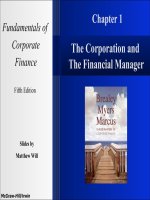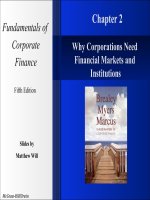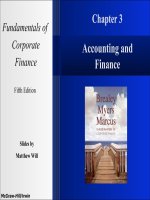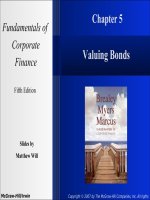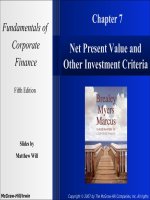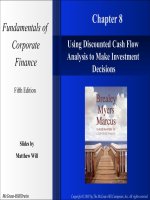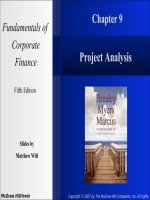Fundamentals of corporate finance 5e mcgraw chapter 011
Bạn đang xem bản rút gọn của tài liệu. Xem và tải ngay bản đầy đủ của tài liệu tại đây (1.07 MB, 22 trang )
Fundamentals of
Corporate
Finance
Chapter 11
Risk, Return and
Capital Budgeting
Fifth Edition
Slides by
Matthew Will
McGraw-Hill/Irwin
Copyright © 2007 by The McGraw-Hill Companies, Inc. All rights
11- 2
Topics Covered
Measuring Market Risk
Beta
Risk and Return
CAPM
Capital Budgeting and Project Risk
McGraw-Hill/Irwin
Copyright © 2007 by The McGraw-Hill Companies, Inc. All rights
11- 3
Measuring Market Risk
Market Portfolio - Portfolio of all assets in the economy.
In practice a broad stock market index is used to
represent the market.
Beta - Sensitivity of a stock’s return to the return on the
market portfolio.
McGraw-Hill/Irwin
Copyright © 2007 by The McGraw-Hill Companies, Inc. All rights
11- 4
Measuring Market Risk
Example - Turbo Charged Seafood has the following %
returns on its stock, relative to the listed changes in the
% return on the market portfolio. The beta of Turbo
Charged Seafood can be derived from this information.
McGraw-Hill/Irwin
Copyright © 2007 by The McGraw-Hill Companies, Inc. All rights
11- 5
Measuring Market Risk
Example - continued
Month Market Return % Turbo Return %
1
+ 1
+ 0.8
2
+ 1
+ 1.8
3
+ 1
- 0.2
4
-1
- 1.8
5
-1
+ 0.2
6
-1
- 0.8
McGraw-Hill/Irwin
Copyright © 2007 by The McGraw-Hill Companies, Inc. All rights
11- 6
Measuring Market Risk
Example - continued
When the market was up 1%, Turbo average % change was +0.8%
When the market was down 1%, Turbo average % change was -0.8%
The average change of 1.6 % (-0.8 to 0.8) divided by the 2% (-1.0 to 1.0) change in the market produces a beta of 0.8.
B =
McGraw-Hill/Irwin
1.6
2
= 0.8
Copyright © 2007 by The McGraw-Hill Companies, Inc. All rights
11- 7
Measuring Market Risk
Example - continued
McGraw-Hill/Irwin
Copyright © 2007 by The McGraw-Hill Companies, Inc. All rights
11- 8
Portfolio Betas
Diversification decreases variability from unique risk,
but not from market risk.
The beta of your portfolio will be an average of the
betas of the securities in the portfolio.
If you owned all of the S&P Composite Index stocks,
you would have an average beta of 1.0
McGraw-Hill/Irwin
Copyright © 2007 by The McGraw-Hill Companies, Inc. All rights
11- 9
Stock Betas
Stock
Beta
Amazon
2.49
DellComputer 1.64
McGraw-Hill/Irwin
Ford
1.34
GE
McDonald' s
.97
.90
Boeing
.76
Wal - Mart
Pfizer
.51
.46
ExxonMobil
.41
H.J.Heinz
.30
B
Betas calculated with
price data from
January 2001 thru
December 2004
Copyright © 2007 by The McGraw-Hill Companies, Inc. All rights
11- 10
Risk and Return
McGraw-Hill/Irwin
Copyright © 2007 by The McGraw-Hill Companies, Inc. All rights
11- 11
Risk and Return
McGraw-Hill/Irwin
Copyright © 2007 by The McGraw-Hill Companies, Inc. All rights
11- 12
Measuring Market Risk
Market Risk Premium - Risk premium of market
portfolio. Difference between market return
and return on risk-free Treasury bills.
Market
Portfolio
McGraw-Hill/Irwin
Copyright © 2007 by The McGraw-Hill Companies, Inc. All rights
11- 13
Measuring Market Risk
CAPM - Theory of the relationship between risk
and return which states that the expected risk
premium on any security equals its beta times
the market risk premium.
Market risk premium = rm - rf
Risk premium on any asset = r - rf
Expected Return = rf + B(rm - rf )
McGraw-Hill/Irwin
Copyright © 2007 by The McGraw-Hill Companies, Inc. All rights
11- 14
Measuring Market Risk
Expected Return (%) .
Security Market Line - The graphic
representation of the CAPM.
Security Market Line
Rm
Rf
Beta
McGraw-Hill/Irwin
1.0
Copyright © 2007 by The McGraw-Hill Companies, Inc. All rights
11- 15
Security Market Line
Return
SML
rf
1.0
BETA
SML Equation = rf + B ( rm - rf )
McGraw-Hill/Irwin
Copyright © 2007 by The McGraw-Hill Companies, Inc. All rights
11- 16
Capital Asset Pricing Model
R = rf + B ( r m - rf )
CAPM
McGraw-Hill/Irwin
Copyright © 2007 by The McGraw-Hill Companies, Inc. All rights
11- 17
Testing the CAPM
Beta vs. Average Risk Premium
Avg Risk Premium
1931-2002
30
20
SML
Investors
10
Market
Portfolio
0
1.0
McGraw-Hill/Irwin
Portfolio Beta
Copyright © 2007 by The McGraw-Hill Companies, Inc. All rights
11- 18
Testing the CAPM
Dollars
Return vs. Book-to-Market
(log scale)
High-minus low book-to-market
2004
Small minus big
/>
McGraw-Hill/Irwin
Copyright © 2007 by The McGraw-Hill Companies, Inc. All rights
11- 19
Stock Expected Returns
Stock
Beta
Amazon
20.4
DellComputer 14.5
McGraw-Hill/Irwin
Ford
12.4
GE
McDonald' s
9.8
9.3
Boeing
8.3
Wal - Mart
Pfizer
6.6
6.2
ExxonMobil
5.9
H.J.Heinz
5.1
E (r )
Copyright © 2007 by The McGraw-Hill Companies, Inc. All rights
11- 20
Capital Budgeting & Project Risk
The project cost of capital depends on the use to which
the capital is being put. Therefore, it depends on the
risk of the project and not the risk of the company.
McGraw-Hill/Irwin
Copyright © 2007 by The McGraw-Hill Companies, Inc. All rights
11- 21
Capital Budgeting & Project Risk
Example - Based on the CAPM, ABC Company has a cost of
capital of 17%. [4 + 1.3(10)]. A breakdown of the
company’s investment projects is listed below. When
evaluating a new dog food production investment, which
cost of capital should be used?
1/3 Nuclear Parts Mfr. B=2.0
1/3 Computer Hard Drive Mfr. B=1.3
1/3 Dog Food Production B=0.6
AVG. B of assets = 1.3
McGraw-Hill/Irwin
Copyright © 2007 by The McGraw-Hill Companies, Inc. All rights
11- 22
Capital Budgeting & Project Risk
Example - Based on the CAPM, ABC Company has a
cost of capital of 17%. (4 + 1.3(10)). A breakdown of
the company’s investment projects is listed below.
When evaluating a new dog food production
investment, which cost of capital should be used?
R = 4 + 0.6 (14 - 4 ) = 10%
10% reflects the opportunity cost of capital on an
investment given the unique risk of the project.
McGraw-Hill/Irwin
Copyright © 2007 by The McGraw-Hill Companies, Inc. All rights

